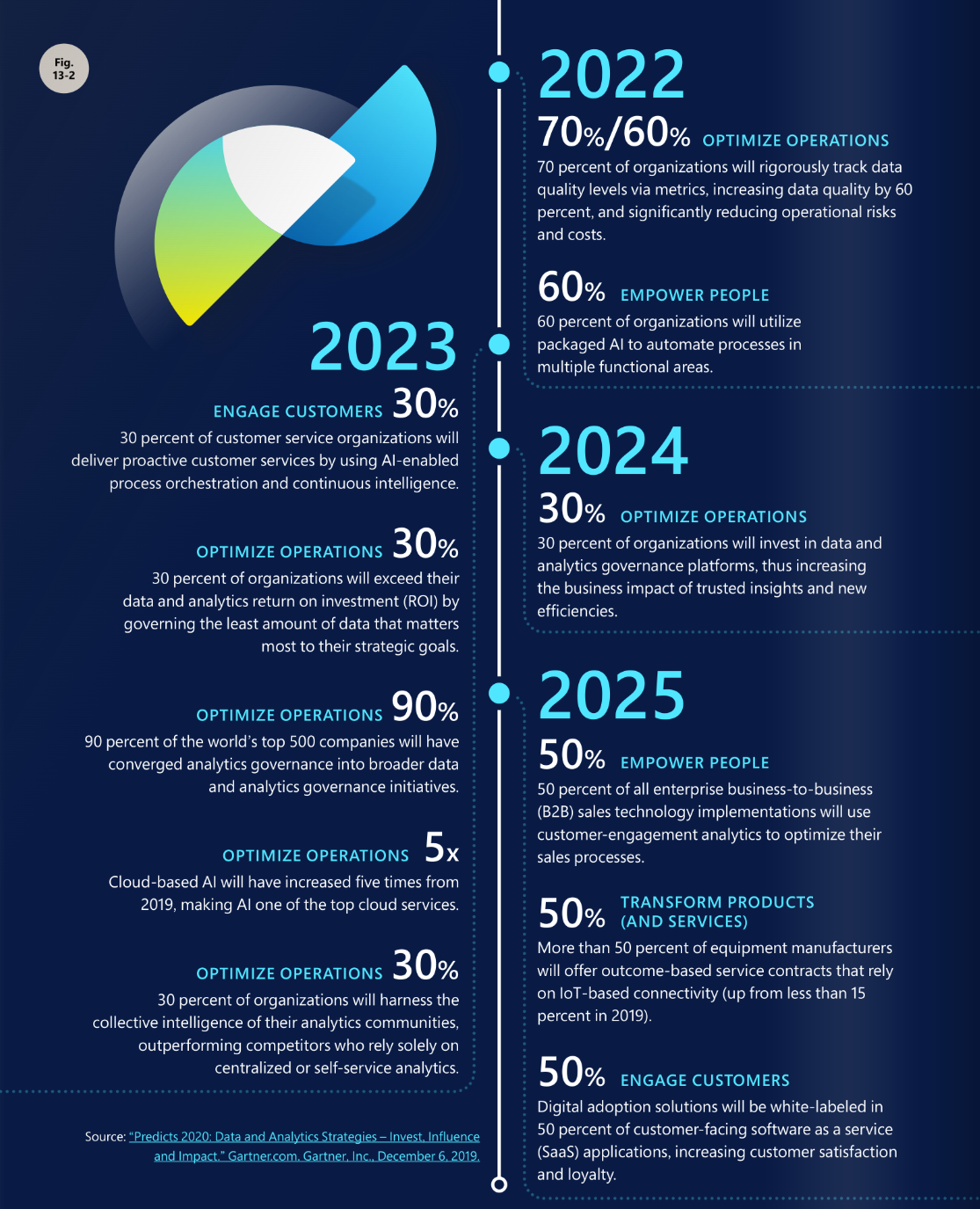The data estate and data modernization in Dynamics 365
Your data estate is the infrastructure that helps you manage all your data, no matter where or how it's stored. To get immediate insights from your data, you need a fast, agile, accessible, secure, and highly scalable modern data platform.
Legacy applications often store data and collect it through the same interface. Data modernization changes how you collect, store, and manage data by using innovative technology. It also uses AI and data analytics solutions to optimize how you review data. To improve your business performance, you need to design and manage your data estate based on a modern platform that breaks down silos and unleashes the full potential of your data.
Build a data strategy
Your business solutions can only deliver the results you want if your data strategy has a clear vision that aligns your business intelligence investments with your business goals. This way, you can maximize the impact of your data, drive growth, and increase profitability.
To define your data strategy, start with the questions you need to answer to meet your goal of using data to make better decisions that improve your business outcomes.
Your customers have access to more information and channels than ever before. Your data strategy should reflect their journey. From a data management perspective, make sure all channels and checkpoints across the customer journey are represented.
A common risk for businesses is poor quality of their data. If your data is weak, unstructured, unsecured, or hard to use or access, you'll need more work to move, clean, protect, and improve it. Poor quality also leads to lost opportunities, failure to attract customers consistently, more time and money spent on cleaning or correcting errors, and inaccurate or inconsistent performance measurements.
Modernize your data estate
Your strategy for modernizing your data estate should map out the current state of your estate and the goals, processes, and requirements for the future state. It should identify key analytics and metrics that will improve your business and align with your goals.
Cloud-based solutions offer modern capabilities based on machine learning and AI to analyze parts of your data and automate other processes such as solving quality issues. You can use prebuilt models for common analysis use cases instead of building custom models. Using legacy solutions can create a gap in the future. AI and machine learning solutions take a modern approach to data and analytics that grows with technology. You can add new features and capabilities in the future and avoid falling behind your competitors.
Some organizations focus more on collecting than analyzing their information sources. It's important to identify gaps in achieving objectives rather than focusing only on the structure or tools.
The modern data estate and the digital feedback loop
Gartner, Inc. predicted in 2020 that investments in data and analytics strategies will affect businesses critically in the years ahead.
How you modernize your data estate depends on the four data signals in the digital feedback loop.
Empower people
Your employees need tools, resources, and timely access to information to do their jobs well. Using AI to automate business processes leads to better and faster results. This empowers your people to make the best decisions and deliver value to your customers.
Engage customers
Modern applications use AI and data analytics to optimize business processes and show you customer activity. For example, Dynamics 365 apps can give a customer service agent real-time insights into a customer's interests and buying behavior. The agent can then make personalized suggestions for the customer. These insights help you engage your customers intelligently and provide excellent service.
Transform products and services
Your products and services are sources of data that give you better insights into their lifecycle information. You can use these insights to benefit your organization and your customers. By analyzing these insights, you can transform your products and services to take advantage of new opportunities, channels, or markets. For example, a smart air conditioner that lets you set an optimal temperature through an app can also learn from your daily routine to make sure the house is cool when everyone gets home. The manufacturer then uses data from all users to improve the product's smart features, creating a continuous improvement cycle.
Optimize operations
Cloud-based AI is a common investment area for most organizations, and not just for customer-facing technology. For example, Dynamics 365 Field Service can use AI to predict hardware failures on a manufacturing floor and send technicians before the equipment breaks down. Organizations that optimize their operations with augmented analytics, AI, and embedded intelligence will be more competitive in the market.
Next steps
- Explore the components of the modern data estate, such as data sources, data integration, data storage, data processing, and data consumption
- Use the Success by Design checklist to assess and improve your reporting and analytics strategy
Commentaires
Bientôt disponible : Tout au long de 2024, nous allons supprimer progressivement GitHub Issues comme mécanisme de commentaires pour le contenu et le remplacer par un nouveau système de commentaires. Pour plus d’informations, consultez https://aka.ms/ContentUserFeedback.
Envoyer et afficher des commentaires pour
